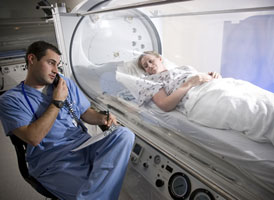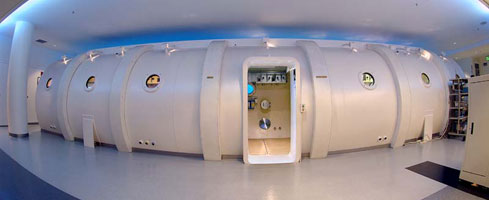Hyperbaric Medicine
Hyperbaric Medicine, also known as Hyperbaric Oxygen Therapy (HBOT), is the medical use of oxygen at a higher pressure than atmospheric pressure (1 atm). This therapy is performed in a hermetically sealed chamber within which patients can inhale 100% oxygen.
The procedure is carried out with sessions planned by trained personnel who monitor the patient and adjust the sessions as needed.
Initially, HBOT was used in the treatment of decompression sickness, but later it has been found to be very effective in the treatment of gas gangrene and carbon monoxide poisoning. Recent research indicates that this therapy can also treat several other diseases.
Main effects of HBOT
- The direct action of pressure or mechanical action
The increase in pressure reduces gas bubbles until they become microscopic and are considered dissolved in fluids (Boyle's law)
This effect is utilized in the treatment of Decompression Sickness and Gas Embolism whether iatrogenic or not.
- The increase in partial pressure of oxygen.
During the inhalation of 100% Oxygen in a Hyperbaric environment, the amount of Oxygen dissolved in plasma increases (Henry's law)
At 3 ATA when inhaling 100% O2, the amount of O2 dissolved in plasma is 6.8 vol%, while 6 vol% is the amount of oxygen needed by tissues to meet vital needs.
- Reduces edema
- Stimulates collagen production
- Stimulates osteogenesis
- HBOT has the effect of a broad-spectrum antibiotic in various infections (especially anaerobic)
- Antitoxic (in CO poisoning)
Indications
- Gas Embolism
- Carbon monoxide (CO, or Cyanides) poisoning.
- Gas Gangrene (Clostridial Myositis, Myonecrosis).
- Crush Injury, Compartment Syndrome, Acute Traumatic Ischemia.
- Decompression Sickness.
- Arterial Insufficiencies: Central Retinal Artery Occlusion, Selected Problematic Wounds (Diabetic Ulcers, Venous Ulcers, Pressure Sores, Ulcers from Arterial Insufficiency)
- Severe Anemias (Hemorrhagic Anemias).
- Intracranial Abscesses.
- Necrotizing Soft Tissue Infections.
- Chronic Osteomyelitis.
- Soft Tissue and Bone Radionecrosis.
- Unsuccessful Grafts and Flaps.
- Severe Acute Burns.
- Sudden Idiopathic Hearing Loss (sensorineural)
Hyperbaric chambers
The photos below show what a hyperbaric chamber looks like.


